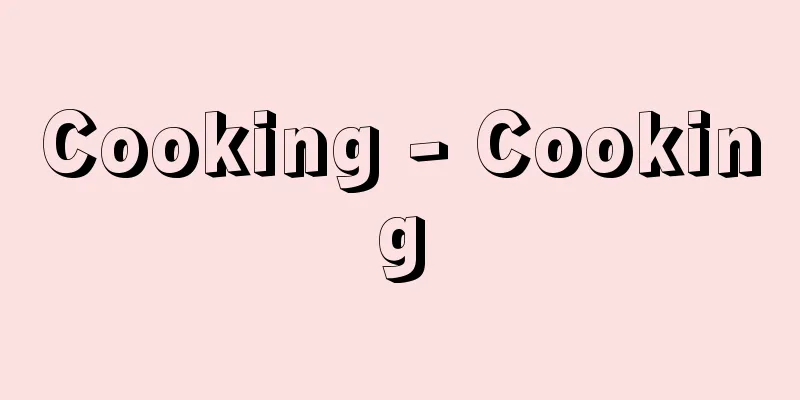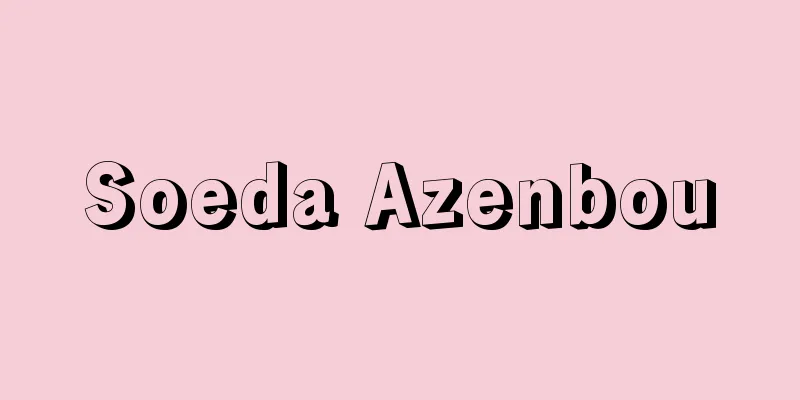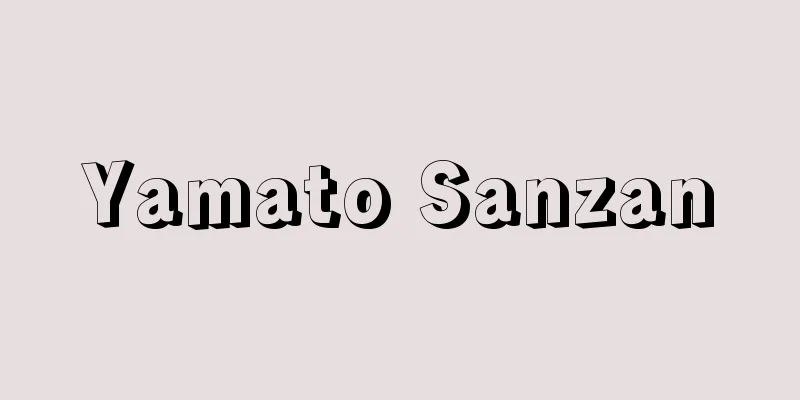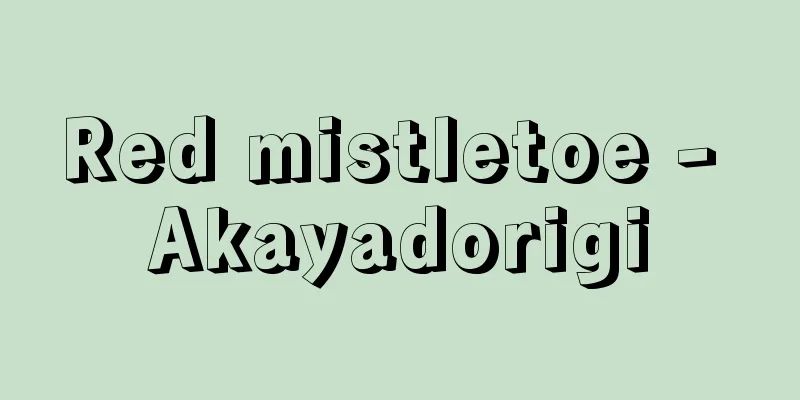Cooking - Cooking

|
The word "ryouri" has been around since the early Heian period. It was originally used to mean to measure or handle things well, but it soon came to be used exclusively for food. However, up until the Meiji and Taisho periods, there were also expressions such as "cooking national politics." Cooking refers to the act of preparing food either as is or in combination with other foods to make it palatable, or to heat and season each ingredient accordingly. In China, the word "kassen" has existed for 3,000 years. It refers to making ingredients palatable for the purpose of eating, such as peeling, gutting, removing fish scales, removing bones, removing plant roots, and cutting food into small pieces, using ingredients as they are without applying heat. In old Japanese, "kassen" is read as "azarakekiwosaku." Azarakeki means raw fish or fresh fish. Cooking can also be called "ryouri" or "kappou," but "kassen" means to cut, meaning to eat raw, and "hou" means to cook, meaning to cook, and refers to cooking and seasoning. In addition, the English word "cook" means "to cook food (through fire)" or "to boil or stew," with the emphasis on "heating." Although ingredients and cooking methods vary from country to country and region to region, cuisines from all over the world have been introduced to Japan since the Meiji period. In particular, in recent years, international flavors have been incorporated into home cooking, and it seems that the boundaries between cuisines have become blurred. Nevertheless, Japanese cuisine is generally often divided into three major categories: Japanese cuisine, Chinese cuisine, and Western cuisine. For cuisines of each country or ethnicity, please refer to the sections such as "French cuisine," "Chinese cuisine," "Russian cuisine," and "Japanese cuisine." [Tetsunosuke Tada] Origins of the dishIt is said that humans started using fire to cook food 20,000 years ago, while some say it was 100,000 years ago. This is thought to vary considerably depending on the region. If a spontaneous forest fire burns down a wide area, people living nearby cannot hunt. On their way to other regions, they are forced to eat animals and wild birds found in the burnt ruins, and some of them taste quite good. Some plant-based foods, such as potatoes, may have become more delicious when roasted. It is possible that humans learned to cook food using fire from an accidental forest fire. Indigenous people who lived near volcanoes or had access to hot spring heat would have been able to heat and use food from an early stage. Also, in areas in the south where the sun is strong, they were able to use that heat to cook food. Between 3,000 and 4,000 years ago, humans' knowledge and technology in creating flavors made remarkable progress. China was in the Yin period at that time, and Chinese cuisine at that time showed remarkable progress. At that time, Iin, who is said to have started out as a chef and gone on to hold the highest government position, wrote a famous book called "Honmi-ron" (The Theory of Taste), which is an accurate theory even from a modern scientific point of view, and can be said to be a standard text on cooking theory. In the following Zhou dynasty, royal cooking was managed on a large scale, and the results of that research form the basis of modern cooking. In Japan, during the reign of Emperor Keikō, his attendant Iwakamutsukari-no-mikoto was ordered to cook fish and shellfish on the Boso Peninsula, and Mutsugari-no-mikoto cut the fish and shellfish into appropriate pieces, washed them in seawater, and presented them to him. The emperor praised the deliciousness of the dish, and according to the "Nihon Shoki," he appointed Mutsugari-no-mikoto to be the hereditary head of the palace cuisine. [Tetsunosuke Tada] Types of cooking methodsCooking methods that involve heating can be broadly divided into five types: fire, water, wood, metal, and earth. "Fire" refers to direct heat. It is a method of heating ingredients by placing them directly close to a heat source, and grilling fish and potatoes are examples of this type of method. Although it is generally called "grilled food," there are also grilled dishes such as beef steaks grilled on an iron plate. "Water" is heating using steam, and is a cooking method for dishes called "steamed food." There are methods where the whole dish is steamed, such as steamed rice bowls, and methods where the dish is steamed as a preparation for a dish. An example of this is the steaming used to make grilled eel. "Wood" is a method of heating through wood. It creates a soft flavor through wood, which is a poor conductor of heat, and cedar grilling, which is heated using cedar planks, is an example of this type. "Metal" has many types. It is a type of dish that uses a metal pot to cook stews, fried dishes, stir-fried dishes, and other dishes. Moreover, even if the pot is made of the same metal, there are differences in cooking methods depending on the material of the pot, such as iron, copper, or aluminum. "Earth" refers to cooking methods that use not only earthen pots, but also ceramic plates, stones, etc. Earthen pots are effective for dishes such as turtle hotpot, mizutaki, and nabeyaki udon. Another example of "earth" cooking is burying potatoes in the ground and cooking them over a bonfire. Other examples of "earth" cooking methods include Miyazaki Prefecture's local dish, Hyuga stone-grilling (where fish and vegetables are boiled in a hot stone), Akita Prefecture's Oga Peninsula stone-grilling (where fish is put in a pot, water is added, and heated stones are placed inside the pot for cooking), and Sado stone-grilling (where sweetfish is grilled on a heated stone plate). Heating methods can be broadly divided into five types as above, but there are also dishes that are steamed and grilled, or grilled and boiled, and sometimes heating methods are used in two or three layers. There are also cooking methods that do not heat sashimi or some vinegared dishes at all. Furthermore, there are various dishes that are made by reprocessing ingredients. Examples are fish pastes such as kamaboko, hanpen, and chikuwa, as well as sesame tofu and kinton, which are made mainly from kuzu starch and sesame seeds. Nikogori, which is made by boiling and cooling flounder, stonefish, and gurnard, and the gelatinous qualities of the fish come out and solidify, is a typical example of yosemono, and is a reprocessing dish along with Takikawa tofu, which is made by solidifying soy milk with agar liquid. Aemono, which are dishes that use raw, boiled, or fried foods as the main ingredients and add other ingredients to enhance the flavor or increase the nutritional value, come in many varieties. For sesame dressing, sesame seeds are used as they are, cut and roasted, or half-ground or well-ground. There are various types of salads, such as oroshi-ae (a type of salad made with grated daikon radish), shira-ae (a type of salad made with grated tofu), umeboshi-ae (a type of salad made with pickled plum), yolk with vinegar, wasabi-ae (a type of salad made with sea urchin), and kowata-ae (a type of salad made with sea urchin). Soups are broadly divided into miso soup and clear soup, but there are also many other types, such as kasu-jiru (a type of soup made with lees) and surinashi-jiru (a type of soup made with pureed soybeans). Furthermore, food appeals to the visual sense through its presentation and color scheme, and the sense of smell and touch also greatly affect the sense of taste. In short, all five senses are involved in human food, and food is also a reflection of the lifestyles of the times. In other words, food must be considered to reflect the fashions of the times, and a good aftertaste is also desired. What is known as a "good aftertaste" is necessary. [Tetsunosuke Tada] Cuisine and CultureHumans obtain food by gathering food from the environment and by raising and cultivating it, but they do not eat these ingredients as is, but rather by adding various processes to them. Cooking refers to the food that has been processed by humans and the act of doing so. Methods include so-called preparation, such as washing, cutting, peeling, removing the bitterness, removing excess material, and grinding into powder, as well as heating by boiling, baking, steaming, frying, fermenting, drying, adding seasonings, and combining and serving the food. However, humans do not consider all edible and nutritious things in the environment surrounding them as food, but rather consider only a portion of them as "food" and do not consider the rest as "not for humans to eat" unless they are in a state of starvation. The choice of food varies from culture to culture even in the same environment, because the act of "eating" is an act in which humans take in things from the outside world into themselves in the form of food, and is not an act solely for survival. In other words, the act of eating is deeply connected to the worldview, which has gradually become clear through research into primitive societies. It was generally thought that in primitive societies where the conditions for survival were harsh, humans would eat anything that was edible, but in fact the opposite is true, and there are many taboos regarding food. For example, the meat of four-legged animals was the subject of strict taboos for the Japanese until about 100 years ago, and even today some people do not consider their internal organs to be "food". Fish was the main animal food of the Japanese, but with the exception of some, they rarely eat internal organs. Europeans eat only a small portion of the fish and shellfish they can get, and northern Europeans do not consider squid, octopus, etc. to be human food. Even if they are not recognized as taboo by the people themselves, many of the things they do not eat because they are "tasteless" are not the object of their taste as a result of their non-selection of foods based on their worldview. The above suggests that cooking methods are also linked to worldviews. In fact, there are many cases in which cooking methods for boiling and grilling are linked to important categories in life, such as men and women, the inside and outside of the living space, and the sacred and the profane, depending on the society. In Anglo-Saxon cultures, the main dish for traditional events such as Christmas is grilled meat, and the custom remains that the head of the household (male) carves it up. French cultural anthropologist Lévi-Strauss, who seeks to clarify the structure of culture, argues that fire is a medium that connects the "nature" and "wildness" that surrounds us with the "culture" that humans have created, and that by using fire, humans incorporate "nature" into their "culture" in a modified form, and that the taboos and rules related to cooking reveal this structure. Religious ceremonies and annual events often involve traditionally prescribed dishes and cooking methods, such as eating raw fish and steaming grains at Japanese Shinto ceremonies. Foods associated with annual events, such as chimaki (rice dumplings) and Okinawan muchi, are required to be wrapped in ritual plants believed to have ward off evil spirits. In our highly industrialized society, where a wide variety of food is constantly and abundantly supplied, food and cooking taboos and rules have faded and their meanings are harder to understand. However, we can still get fragmented glimpses of the food and cooking taboos and rules that our culture once had, for example, in linguistic expressions such as "being forced to eat cold rice." [Emiko Namihira] [Reference] | | | | | | | | | |Source: Shogakukan Encyclopedia Nipponica About Encyclopedia Nipponica Information | Legend |
|
料理ということばは平安朝の初期からある。物や物事を、はかりおさめる、うまく処理する意に用いていたが、まもなく食べ物専用のものになった。しかし、明治、大正のころまで「国政を料理する」などの言い方もあった。 料理とは、食品を適宜にそのまま、または他の食品と組み合わせて食べよくするか、それぞれの材料に応じて加熱し味を調えるもの、あるいはその動作をいう。中国では3000年の昔から割鮮(かっせん)ということばがある。食べる目的でその材料を食べよくすること、たとえば皮をむくとか内臓を抜く、魚の鱗(うろこ)をとる、骨を抜く、植物の根をとる、食品を細かく切るなど、熱を加えずそのまま用いるものをいうのである。割鮮は古い日本語ではアザラケキヲサクと訓じている。鮮(あざら)けきは生(なま)の魚、鮮魚の意である。料理をすることを「調理」「割烹(かっぽう)」ともいうが、割は割(さ)くの意で生食をいい、烹(ほう)は烹(に)(煮)るの意で加熱して味つけしたものをいうのである。なお、英語のcookは「(火を通して)食物を料理する」「煮炊きする」という意味の語で、「加熱」に重点が置かれている。 料理は国により地方によって、材料も調理法も異なっているが、日本には明治以降世界各国の料理が入ってきた。とくに最近では、家庭料理のなかにも世界の味が取り入れられて、料理の国境は薄れた観がある。それでも日本の料理においては、一般に日本料理、中国料理、西洋料理と三大別されて扱われることが多いようである。 各国あるいは民族の料理については、それぞれ「フランス料理」「中国料理」「ロシア料理」「日本料理」などの項目を参照されたい。 [多田鉄之助] 料理の起源人類が火を利用して火食を始めたのは2万年前ともいわれるし、10万年前だという説もある。これは地域によってかなり相違があると考えられる。自然発火による山火事で、広範囲を燃え尽くしたとすると、その近くに住む民族は狩猟ができない。他の地方へ移動する途中、焼け跡にある動物や野鳥をやむをえず食べてみると、なかなか味がいいものがある。植物性のものでも、いも類などは焼けて味がよくなったものもあろう。こうして偶然の山火事から、火食を覚えたということも考えられる。火山の近くや温泉熱を利用できる原住民は、早くから食品を加熱して用いることができたであろう。また、南方の太陽熱の強い地方では、それを利用して火食をすることができたのである。3000~4000年前になると、人類の味づくりの知恵と技術は著しく進歩した。当時の中国は殷(いん)の時代であるが、そのころの中国料理は目覚ましい前進ぶりを示していた。当時、料理人から出発して最高位の政府要職についたといわれる伊尹(いいん)の名著『本味論』は、現在の科学の見地からみても正確な理論で、これは料理理論の基準書であるともいえよう。次の周代になると王室料理は大規模な組織運営をされ、その研究によって得た成果は現在の料理の基礎になっている。日本の場合は、景行(けいこう)天皇のとき、房総半島で、随行の磐鹿六雁命(いわかむつかりのみこと)に魚貝類の料理を命ぜられ、六雁命は魚貝を適宜に切り海水で洗って献上した。その味のよさを嘉賞(かしょう)した天皇は、六雁命に世襲で宮中料理の担任を命じたと『日本書紀』にある。 [多田鉄之助] 料理法の種類加熱する調理の方法は、火、水、木、金、土の5種類に大別できる。「火」は直火(じかび)の意である。熱源に直接材料を近づけて加熱する方法で、魚を焼く、いもを焼くなどがその部類に属する。一般に「焼き物」と称しているが、鉄板で焼くビーフステーキのような焼き物もある。「水」は水蒸気を用いて加熱するもので、「蒸し物」と称する料理の調理法である。茶碗(ちゃわん)蒸しのように器ごと蒸すものと、料理の下ごしらえとして蒸すものがある。ウナギの蒲(かば)焼きをつくるときに蒸すなどが、それである。「木」とは、木質を通じて加熱する方法である。熱の不良導体である木質を通してふんわりとした味を形成するのだが、杉板を用いて加熱する杉焼きなどがこれに属する。「金」は種類が多い。煮物、揚げ物、炒(いた)め物など金属の鍋(なべ)を用いてつくる料理である。それに同じ金属でも、鉄、銅、アルミニウムなど鍋の材質によっても調理法に相違が出てくる。「土」は土鍋ばかりでなく陶板、石などを用いた調理法である。すっぽん鍋、水炊き、鍋焼きうどんなどには、土鍋が効果的である。このほか、地中にいもを埋め、その上でたき火をして加熱するのも「土」に属する。宮崎県の郷土料理である日向(ひゅうが)の石焼き(熱した石を鍋にして魚や野菜を煮る)や、秋田県男鹿(おが)半島の石焼き(魚を鍋に入れて水を加え、熱した石をその中に入れて加熱する)、佐渡の石焼き(熱した石板でアユを焼く)なども「土」に属する調理法である。加熱法は以上のように5種類に大別できるが、蒸して焼いたり、焼いて煮る料理もあって、加熱法が二重、三重に重なって用いられることもある。 また、刺身や酢の物の一部など、全然加熱しない調理法もある。さらに、材料を再加工してつくる料理もいろいろある。かまぼこ、はんぺん、ちくわなどの練り物がそうで、葛粉(くずこ)と当たりごまを主材料にしてつくるごま豆腐とか、きんとんもこれに属する。カレイ、オコゼ、ホウボウなどを煮て冷ますと、魚のゼラチン質が出て固まる煮こごりは「寄せ物」の代表格で、豆乳を寒天液で固めた滝川豆腐などとともに、再加工してつくる料理である。「和(あ)え物」は、生物(なまもの)、煮物、揚げ物などを主材料にして、他の材料を加えて味を高め、あるいは栄養価を増す方法で、その種類は多い。ごま和えには、ごまを炒(い)ったまま、切って用いる、半すり、よくすったものなどがある。大根おろしを用いるおろし和え、豆腐をすって調味した白(しら)和え、梅肉和え、黄身酢和え、わさび和え、うに和え、このわた和えなどがある。「汁物」はみそ汁と澄まし汁に大別されるが、ほかに粕(かす)汁、すり流し汁など多くの種類がある。 なお、料理は盛付け、配色など視覚にも訴え、嗅覚(きゅうかく)、触覚なども大きく味覚に影響を与える。要するに人類の食べ物には五感がみな関与するし、料理は時代生活の反映でもある。つまり、料理にも時代のファッションがあるとみなければならないし、食後感のよさも望まれる。いわゆる「後味(あとあじ)のよさ」が必要となる。 [多田鉄之助] 料理と文化人間はその環境のなかから食物になるものを採集したり、食料を飼育や栽培によって得ているが、それらの材料をそのまま食べず、さまざまな人手を加えて食べる。料理とは、そのような人手を加えた結果の食物やその行為をいう。その方法は、洗う、切る、皮や殻をむく、あく抜きをする、余分なものを取り除く、粉にするなど、いわゆる下ごしらえから、煮る、焼く、蒸す、揚げるなどの加熱、発酵、乾燥、調味料を加えること、取り合わせや配膳(はいぜん)なども料理のなかに含まれる。 ところで、人間は、自分を取り巻く環境のなかから食べることが可能なもの、栄養分となりうるもののすべてを食物とするのではなく、そのなかの一部だけを「食物」と考え、他は飢餓(きが)状態にでも陥らなければ「人間が食べるものではない」と考えて食料とはしない。このような食料の選択の対象は、環境が同じであっても文化によって異なっており、それは、「食べる」という行為が、外界に存在するものを、人間が食料という形で自らの内側に取り込む行為であって、単に生存のためだけの行為ではないからである。つまり、食の行為は世界観と深くかかわっており、それは未開社会の調査などを通してしだいに明らかになってきた。一般には、生存条件の厳しい未開社会では、人間は食べられるものはなんでも食べるかのように考えられていたが、事実は逆であって、食に関する数多くのタブーが存在する。たとえば、日本人にとって4本足の動物の肉は100年ほど前までは厳しいタブーの対象になっていたし、内臓に至っては、現在でも「食物」とみなさない人々もいる。魚は日本人の主要な動物性食品であったが、内臓は一部を除いてはほとんど食べない。ヨーロッパ人は獲得可能な魚貝類のごく一部しか食料としないし、北部ヨーロッパ人はイカ、タコなどを人間の食物とは考えていない。タブーとして当の人々には認識されていなくても、「まずいから」という理由で食べないものの多くは、彼らの世界観に基づく食料の不選択の結果、味覚の対象にならなかったのである。 以上のことは、料理法にも世界観との結び付きが存在することを示唆している。事実、社会によって、煮る料理法と焼く料理法とが、男と女、居住空間の内側と外側、聖と俗など、生活の重要な分類と結び付いている事例は多い。アングロ・サクソン系の文化では、クリスマスなどの伝統的行事の主要料理は焼いた肉であり、その家の主人(男)が切り分ける習慣が残っている。文化の構造を明らかにしようとするフランスの文化人類学者レビ・ストロースは、火というものが、人間が自分たちを取り巻く「自然」や「野性」と、人間がつくりあげた「文化」とをつなぐ媒介物であり、人間は火を使用することによって「自然」を変化させた形で「文化」のなかに取り込むのであり、料理にかかわるタブーやルールは、その構造を明らかにするという。 宗教的儀礼や年中行事には、伝統的に定められた料理を伴うことが多く、その料理法も決められている。たとえば、日本の神事での魚の生食や、穀物を蒸すことなどである。粽(ちまき)や沖縄のムーチーのような年中行事と結び付いた食品は、魔除(まよ)けの効力があると信じられている儀礼的植物を用いて包むことが定められている。 多様な食料が常時、しかも豊富に供給される高度産業化社会では、食や料理に関するタブーやルールは薄れ、その意味も理解されにくくなっているが、それでもなお「冷飯(ひやめし)を食わされる」などの言語表現のなかなどに、われわれの文化がかつてもっていた食や料理のタブーやルールを、断片的にではあっても知ることができる。 [波平恵美子] [参照項目] | | | | | | | | | |出典 小学館 日本大百科全書(ニッポニカ)日本大百科全書(ニッポニカ)について 情報 | 凡例 |
<<: Food and drink consumption tax - Ryōriinshokutōshōhizei
>>: Lee Yong-ik (English spelling) (R)I Yong-ik
Recommend
Stroheim - Erich von Stroheim
American film director and actor. Born September ...
Tenkodogo
…Although there was a military commander directly...
Rebellion - Muhon
Treason against the state, rulers, and those in po...
Ghawar Oil Field
The world's largest oil field, located east o...
Rhacomitrium canescens (English spelling) Rhacomitrium canescens
… [Kitagawa Takashi]. … *Some of the terminology ...
Abbeglen, C.
…Since J.C. Abbeglen in his book The Japanese Fac...
Lucanus maculifemoratus
… [Chokane Hayashi]. … *Some of the terminology t...
Bitter cress
...It is widely distributed in the Northern Hemis...
Shinmeisha - Shinmeisha
[1] [Noun] Since the Middle Ages, this shrine has ...
talent
〘noun〙 (talent)① Talent. Especially artistic or ac...
Minicoy Island
…A group of coral reef islands in the Arabian Sea...
monophonic system
...When listening through speakers, it should be ...
Beginning of summer
One of the twenty-four divisions. It is believed t...
Heiryo
A prefecture-level city in the eastern part of Ga...
Orphan of the Storm - Stormbringer
...The plan to remake "Fading Flowers" ...









